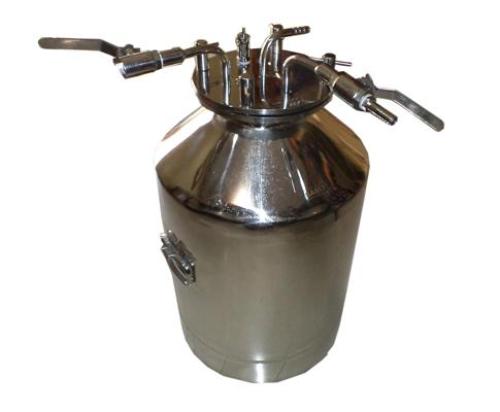Pressure vessels, autoclaves and steam sterilizers operating at pressures greater than 15 pounds per square inch gauge (psig) and larger than five cubic feet (ft3) volume fall within the Washington State Boiler and Pressure Vessel Code. As such, they have strict requirements for design, testing and approval.
Using autoclaves and small pressure vessels
Autoclaves and small pressure vessels must have American Society of Mechanical Engineers (ASME) and Underwriters Laboratory (UL) certifications, unless exempted by size and operating pressure. Staff and lab workers must follow manufacturer’s operating, inspection, testing and maintenance instructions. An inspection is required every two years by the Washington State Department of Labor & Industries (L&I) or its authorized agent. If the equipment is physically damaged, it must be repaired and recertified, or taken out of service and disposed.
What you can do to stay safe
Procuring and operating autoclaves and other small pressure vessels
- Ensure your autoclave or pressure vessel is designed and constructed in accordance with the ASME Boiler and Pressure Vessel Code, as indicated by a placard.
- If you are on the Seattle campus, notify UW Facilities to include your pressure vessel in their inventory for periodic inspection by (L&I); look for a state ID sticker (green stamp) on the equipment, indicating it has been inspected by the agency every two years.
- Refer to the Biohazardous Waste page for autoclave safety information.
Developing and setting up research pressure vessels and apparatus
- Use vessels or components that have been certified (e.g., ASTM, ASME, UL), or at least tested by the manufacturer, to withstand your operating pressures, plus a margin of safety (verified through manufacturer’s listing or calculations by a qualified engineer).
- Include a qualified engineer to perform design calculations with appropriate safety factors.
- Limit operating pressure to 15 pounds per square inch (psi) and provide a pressure relief valve not to exceed 15 psi.
- Request review and approval of your research pressure vessel by EH&S and L&I, if required, before operating it.
- Use a metal or shatter-proof glass or plastic screen to protect personnel from physical injury.
- Use a pressure relief valve that is just above the operating pressure but well below the pressure limit of the vessel.
- Limit and carefully control the application of heat.
- Provide a pressure regulator that is appropriate and designed for the system.
- Periodically inspect the equipment setup for physical damage or stress.
- Use a lower pressure or a different system (e.g., a pump) if it will not adversely affect the research.
- Consider all conditions that may affect the pressure vessel (gas versus liquid, heating/cooling, corrosion).
- Wear your safety glasses, lab coat and any other designated personal protective equipment.
Frequently asked questions
The pressure differential between the inside and outside of the pressure vessel, whether created from chemical reaction, compressed gas, heating, chilling, cooling or vacuum, is a potential hazard. Many serious or fatal accidents have occurred when a pressure vessel or a component failed and generated flying projectiles or released hazardous materials.
Pressure vessels with a pressure greater than 15 psi and a volume greater than 5 cubic feet (ft3) are regulated by Washington state law (Chapter 296-104 WAC). They must have an operating permit and be inspected by a state authorized inspector every two years. Examples include autoclaves and electric boilers.
The UW Facilities' preventive maintenance manager coordinates the regulated inspections and maintains building records for inventoried pressure vessels. If your pressure vessel qualifies and is not inventoried, please contact UW Facilities.
Compressed gas cylinders and tanks traveling on public roads are regulated by the U.S. Department of Transportation and Washington state law (Chapter 296-24 WAC, Part K).Pressure vessels are exempt from regulation if they:
- Have a safety valve set at 15 psi or less or
- Are smaller than 5 cubic feet (ft3)
While these pressure vessels are exempted from state regulation, they can still present a hazard; we recommend that you follow the applicable precautions outlined above to prevent injuries.
Report incidents
UW personnel are required to submit an incident report to Environmental Health & Safety for any work-related event that results in an injury, illness, exposure to hazardous materials, or fire, regardless of the work location. UW personnel are highly encouraged to submit work-related near-miss events. Visit the Incident Reporting page for more information.
More Information
Washington Administrative Code Chapter 296-104 WAC
Washington Administrative Code (Chapter 296-24 WAC, Part K).
A pressure vessel is a closed container designed to hold gases or liquids at a pressure substantially higher or lower than the ambient pressure. Examples include glassware, autoclaves, compressed gas cylinders, compressors (including refrigeration), vacuum chambers and custom designed laboratory vessels.
Definitions
A closed vessel under pressure
A boiler in which steam or other vapor is generated at a pressure of more than 15 psig for use external to itself
A certificate issued by the chief boiler inspector to the owner/user of a boiler or unfired pressure vessel upon inspection by an inspector
The boiler and pressure vessel code of the American Society of Mechanical Engineers with addenda thereto made and approved by the council of the society which have been adopted by the board of boiler rules in accordance with the provisions of RCW 70.79.030

